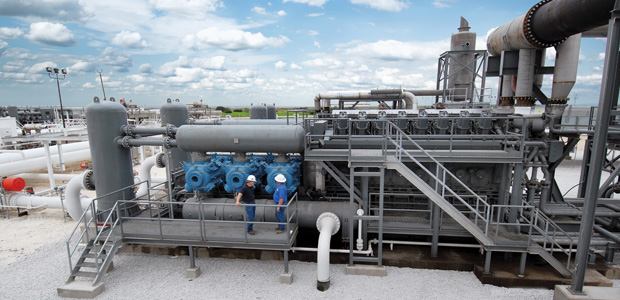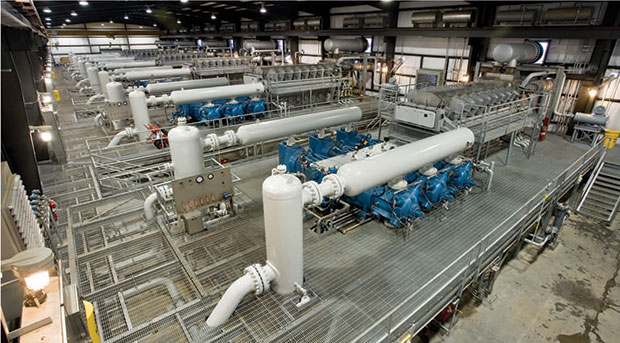
Natural Gas Strategies
Three Key Market Sectors Driving New Demand Loads For Domestic Natural Gas
By Karen Buchwald Wright
MOUNT VERNON, OH.–While tight-sand oil plays have been the catalyst for U.S. activity in recent years, it is worth remembering that the American shale (unconventional) revolution began in natural gas shales. With the world’s attention fixated on oil markets, could natural gas emerge as the key to the industry’s recovery?
That may be hard to determine at the moment, with prices mired in the $2 an MMBtu range on the New York Mercantile Exchange, and gas rig counts at historic lows. However, change is a constant in the cyclical world of natural gas, and the bottom of the cycle invariably gives way to a new upswing. Already, demand-side drivers are in place that have the potential to move the needle quite meaningfully on natural gas consumption.
The good news for consumers is that there is no longer any question about the surety of supply. The development of unconventional resources has resulted in record gas production. Data from the U.S. Energy Information Administration show that marketed production reached 27.3 trillion cubic feet in 2014–the highest annual total on the books–up from 19.5 Tcf in 2004 and 21.6 Tcf in 2009. It is easy to see what is behind the upsurge: Gross withdrawals from shale wells jumped by nearly 10 Tcf between 2009 and 2014, according to the EIA.
Demand is expanding also, with annual U.S. consumption climbing 5 Tcf since 2006, hitting 26.7 Tcf in 2014 (73 billion cubic feet a day). The EIA estimates usage ticked upward by 2.5 Bcf/d, to 27.6 Tcf, in 2015 and projects another 1.1 Bcf/d gain to 28.0 Tcf this year.
However, the incremental growth in demand has not occurred at a sufficient pace to match the supply growth in shale plays, creating an imbalance. But the market is responding to more fully leverage North America’s bounty of clean-burning natural gas.
High-Growth Markets
Three critical growth sectors–petrochemicals, electric generation, and liquefied natural gas exports–will play major roles in realigning supply and demand. By some estimates, demand is expected to increase by double digits over the next five years as new facilities in these sectors enter service.
Converting natural gas molecules into petrochemical products, electricity and a liquid that can be transported around the world will help usher in a new era for the domestic market–one that is defined by a stronger and more stable business environment and supply/demand equilibrium. With the additional demand from these high-base-load applications, I believe natural gas is positioned to pull the domestic industry out of this downcycle, sparking economic renewal both inside and outside the industry.
It is becoming increasingly apparent that oil and gas are among a select few segments of the U.S. economy that have grown in recent years. High levels of oil and gas activity benefitted many other segments because the manufacturing and industrial sectors sit right on top of energy, the base of America’s economy. Contrary to the notion that cheap energy always stimulates the economy, the oil and gas downturn is impacting the broader U.S. economy negatively.
If the rest of the economy was robust, and not essentially stagnant since 2008, then cheap oil and gas probably would drive additional growth. However, given the oversized impact of the shale revolution in the context of the overall economy, current prices, and subsequently a precipitous shutdown throughout the industry, everything else is following suit. The lesson to be learned is that developing domestic oil and natural gas supplies drives many other economic sectors and is good for the nation, not only the energy industry.
Exports: American Freedom
On the last day of 2015–only days after legislation was enacted to end the ban on exporting U.S. crude oil–a tanker set sail from Corpus Christi, Tx., to deliver the first shipment in 40 years of “liquid American freedom” to a port in Europe. And now comes LNG exports, another form of liquid freedom. The first LNG cargo to leave U.S. shores for overseas markets departed Cheniere Energy’s Sabine Pass terminal in Louisiana in late February, signaling an historic opportunity both for the North American natural gas industry and potential consumers around the world.
Hundreds of gas-fired electric generating and petrochemical facilities being built all across the country, along with the first wave of LNG export terminals, are ushering in a new era for the domestic natural gas market. Shown here is a row of large-horsepower reciprocating compressors in a Southern Pine Electric Power Association gas storage and transmission plant in Mississippi.
The geopolitics are complex, but U.S. oil and gas exports provide a powerful strategic advantage for America’s allies around the world. They now have alternatives to OPEC and Russian monopolies, affording them supply stability and sourcing options they would not have otherwise.
LNG also opens the global market to domestic gas. The first four U.S. export terminals are scheduled to commence operations over the next four years: Cheniere’s Sabine Pass plant, Cameron’s plant in Louisiana, Freeport LNG’s facility in Texas, and Dominion’s Cove Point plant in Maryland.
Together, these four terminals have the capacity to liquefy 7 Bcf/d of gas for export around the world! Obviously, 7 Bcf/d is a lot of gas, representing nearly 10 percent of total U.S. demand in 2014. And, even more LNG terminals are in various stages of permitting and construction in the lower-48. In the bigger picture, LNG exports have the potential to stimulate the U.S. economy and support a large number of permanent, high-paying jobs.
What about demand for natural gas as feedstock? According to the American Chemistry Council, 226 petrochemical construction projects had been announced or started in the lower-48 as of April 2015, representing $138 billion in capital investment, and providing 655,000 permanent new jobs and $266 billion in economic output by 2023. In 2014, EIA projected these new facilities would increase demand for ethane by 50 percent (or 600,000 barrels a day) and propane by a factor of four (nearly 200,000 bbl/d) by the end of 2018.
The most remarkable part of the boom in “re-shoring” and new petrochemical plant construction is that it represents a complete reversal from 15 years ago, when petrochemical companies–among the most price-sensitive of all consumers–were leaving the United States in droves because of perceived shortages and high prices. Shale gas has changed the dynamics completely for the U.S. petrochemical industry, and every consumer in the United States stands to benefit from that transformation.
Furthermore, manufacturing is enjoying both significant re-shoring and a renaissance that is transforming the “Rust Belt” to a new era of growth and health. Manufacturing is sensitive to oil and gas prices also because materials used to make virtually everything utilize petrochemical products as base materials (e.g., plastic), utilize natural gas as fuel for processes (e.g., steel), and consume electricity generated by burning natural gas.
Embracing Natural Gas
In fact, with significant increased use of natural gas for electric generation, a report from Boston Consulting Group estimates the average U.S. household stands to save $150-$190 annually on electricity bills over the next decade, not to mention another $280 a year in savings on finished goods and services, and $230 in home heating by 2025.
Natural gas has all but ended coal’s long-standing reign as the dominant fuel source in U.S. power generation. In April 2015, for the first time, more electricity was generated from natural gas than from coal.
The most recent EIA statistics (through November) show that natural gas-fired generation has exceeded coal-fired generation in every month since July, and the gap is widening. In November, natural gas accounted for 101.9 million megawatt-hours of generation versus 87.8 million mw/hr for coal. This is a massive shift in fuel sourcing compared with 10 years ago, when coal’s share of the electric market was more than double that of natural gas.
The transition to natural gas has been under way for several years, and was initiated without any government mandates on fuel switching. Electric utilities are embracing gas for two reasons:
- It can compete head-to-head with coal as the lowest-cost fuel.
- It reduces emissions significantly. In fact, natural gas plants emit 45 percent less carbon per energy unit than coal, and have a much smaller environmental impact.
Moreover, combined-cycle gas plants are relatively simple to build, with favorable capital and long-term operating costs.
In the Marcellus and Utica region alone, six new gas-fired generation plants are being built in Ohio, eight in Pennsylvania, and three in West Virginia. The six Ohio plants will provide 78 percent of the state’s total power requirements when all that capacity comes on line over the next few years. To put that percentage in context, consider that Ohio has ranked historically among the four largest coal-consuming states, and coal accounted for more than 80 percent of statewide generation as recently as 2011.
Environmental Benefits
The move to gas has demonstrated another positive outcome: The United States is leading the world in curbing carbon dioxide emissions, as well as emissions of sulfur, mercury, ash and other pollutants. U.S. CO2 emissions declined by more than 800 million tons between 2007 and 2012, to their lowest level in 20 years.
Even though the United States did not ratify the United Nations' Kyoto Protocol, it was the only industrialized nation to meet 2012 targets for CO2 reductions, primarily because of gas growth in power generation.
Coal displacement is obviously bad news for the coal industry, but the silver lining is that large coal-producing states–including Pennsylvania, West Virginia, Ohio and Wyoming–have significant oil and gas resources, potentially allowing their workforces to transition from coal mining to producing oil and gas.
The simple truth is that there really are no good alternatives to natural gas in the electric sector. Natural gas is “green” and affordable. Coal is environmentally unacceptable, power companies cannot build nuclear because of enormous construction and regulatory costs (as well as staunch public opposition), and renewable solutions such as wind and solar have serious shortcomings, not the least of which are high costs and intermittent productivity, which mean wind and solar farms must be backed up 100 percent of the time with some other kind of power-generation fuel source.
That takes us right back to needing a natural gas, coal or nuclear plant behind every renewable facility. Duplicating resources is neither efficient, environmentally protective, nor cost-neutral.
Instead of subsidizing wind and solar–neither of which are efficient or all that environmentally friendly–America’s natural gas resources should provide the foundation of its energy future. Even if one includes all the compressor stations, pipeline routes and well locations connected in the supply chain to a gas-fired power plant, the environmental footprint is far smaller than that of a solar or wind farm. A single natural gas plant can provide the electric output of thousands of acres of wind mills.
In fact, for wind to generate 100 percent of our electricity needs would require a wind turbine every 900 feet across the continental United States. Additionally, many people question whether the deaths of nearly 3 million birds and bats each year is a price we should pay for so-called green renewables.
Tremendous Endowment
A decade ago, 80 percent of all rigs were drilling for natural gas, and the industry was still assessing the extent of the resources made accessible by horizontal drilling and multistage completions in the Marcellus, Utica, Eagle Ford, Haynesville, and other plays.
I am not sure it is possible to estimate accurately how much supply will be available in 10 years because technology does not stand still. However, it is clear that North America has a tremendous natural gas endowment, enough to keep multiple generations abundantly supplied.
So the resource has been proven, the supply infrastructure is in place, and new markets are being cultivated. Drillers are just waiting for the right price signal.
Fifteen years ago, a gas price of $4 an Mcf was considered the “bottom line.” Anything below $4.00, and generally speaking, operators would not drill new wells. That has been turned on its head, but what is the new bottom-end price at which drilling economics turn negative?
We know this much: As gas prices retreated in 2015, U.S. gas rig counts fell below 300 for the first time since the Baker Hughes weekly survey began tracking gas versus oil rigs in 1987. By the second week of February, only 102 rigs were drilling for natural gas.
It is difficult to draw correlations between rig counts and supply because the new class of rigs drilling in shale plays is so much more productive. The Marcellus and Utica are proof of that. Despite 50 percent rig count declines in both plays over the past year, production reached record levels in 2015.
My guess is that drilling productivity will continue to get better. But even in the Marcellus, where per-well productivity has tripled over the past five years, EIA data show month-to-month drops in production since June, reaching a projected decline of 225 million cubic feet a day in January. That is a tiny percentage of the 15.2 Bcf/d being produced in the Marcellus, but it is a noteworthy departure from the trend line.
While total U.S. dry gas production was up slightly in the first week of February compared with the same week in 2015, the EIA forecasts a marked slowdown in year-to-year production growth (from 5.7 percent last year to 0.7 percent in 2016) as reduced drilling takes a toll.
I believe the numbers for both natural gas supply and demand indicate we are at or near the bottom of the downturn. The situation will not change overnight, but as the new petrochemical, electric generation, and LNG facilities now in the final stages of construction commence operation, the gap between supply and demand will tighten.
The industry is making a massive investment in infrastructure to deliver the oil and gas flowing from shale rock to virtually any place it is needed. Thousands of miles of pipelines have been built and enough new processing capacity has been added in the United States over the past decade to increase the amount of gas processed each year by more than 30 percent.
Every time the industry goes through a slump, it emerges more capable than before. That is true of operators, service companies, and manufacturers. The amazingly innovative people in this industry not only figure out how to do more with less, but how to do it better and cheaper.
As a manufacturer, it is vital for us to retain and continue training our workforce, enhance manufacturing processes, apply new technologies, and improve productivity during the downturn, because when the roller coaster gets to the bottom, it starts moving back up again.
With demand continuing to grow, an upturn is inevitable. The industry has come a long way, but we have only just begun to develop America’s shale gas resources.

KAREN BUCHWALD WRIGHT is chief executive officer, president and chairman of Ariel Corporation, the world’s largest manufacturer of separable reciprocating gas compressors. She began her career at Ariel in 1980, subsequently assuming the position of vice president of administration, and becoming CEO and president in 2001. Under Wright’s leadership, Ariel has more than quadrupled in size and increased its reach both in North America and internationally. She is very active philanthropically, including administering the Ariel Foundation and supporting national charities as well as numerous schools, colleges and universities. A graduate of St. Olaf College, Wright served as vice chairman of the Manufacturing Advisory Council to the President at its inception in 2005, and is a member of the American Petroleum Institute’s board of directors.
For other great articles about exploration, drilling, completions and production, subscribe to The American Oil & Gas Reporter and bookmark www.aogr.com.







